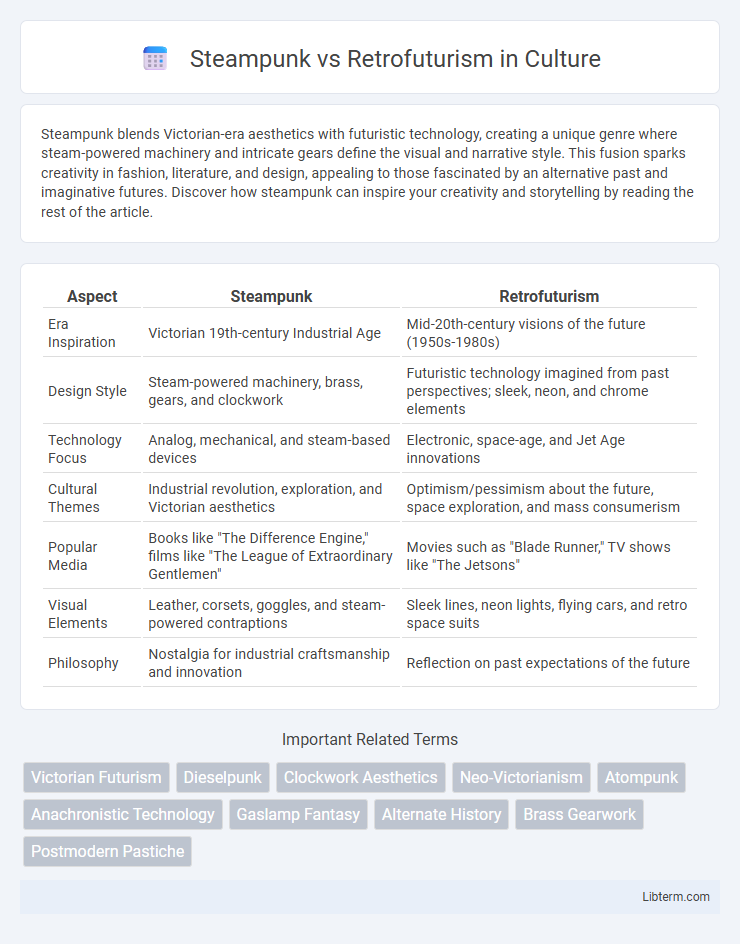Steampunk blends Victorian-era aesthetics with futuristic technology, creating a unique genre where steam-powered machinery and intricate gears define the visual and narrative style. This fusion sparks creativity in fashion, literature, and design, appealing to those fascinated by an alternative past and imaginative futures. Discover how steampunk can inspire your creativity and storytelling by reading the rest of the article.
Table of Comparison
| Aspect | Steampunk | Retrofuturism |
|---|---|---|
| Era Inspiration | Victorian 19th-century Industrial Age | Mid-20th-century visions of the future (1950s-1980s) |
| Design Style | Steam-powered machinery, brass, gears, and clockwork | Futuristic technology imagined from past perspectives; sleek, neon, and chrome elements |
| Technology Focus | Analog, mechanical, and steam-based devices | Electronic, space-age, and Jet Age innovations |
| Cultural Themes | Industrial revolution, exploration, and Victorian aesthetics | Optimism/pessimism about the future, space exploration, and mass consumerism |
| Popular Media | Books like "The Difference Engine," films like "The League of Extraordinary Gentlemen" | Movies such as "Blade Runner," TV shows like "The Jetsons" |
| Visual Elements | Leather, corsets, goggles, and steam-powered contraptions | Sleek lines, neon lights, flying cars, and retro space suits |
| Philosophy | Nostalgia for industrial craftsmanship and innovation | Reflection on past expectations of the future |
Defining Steampunk: Origins and Key Elements
Steampunk originated in the late 20th century as a subgenre of science fiction inspired by 19th-century industrial steam-powered machinery and Victorian aesthetics. Key elements include intricate clockwork mechanisms, brass and copper materials, and anachronistic technology blending futuristic inventions with historical settings. This genre often explores alternate histories and speculative worlds where steam technology remains dominant, distinguishing it from broader retrofuturism themes.
Understanding Retrofuturism: Concepts and Influences
Retrofuturism is a cultural movement and design style that blends past visions of the future with contemporary technology and aesthetics, often drawing inspiration from mid-20th-century science fiction, art deco, and atomic age motifs. It explores how earlier generations imagined the future, highlighting themes of optimism, technological advancement, and societal progress as envisioned in the 1920s to 1960s. Influences from films like "Metropolis," the Jet Age, and pulp magazines play a crucial role in shaping retrofuturism's distinctive blend of nostalgia and innovation.
Aesthetic Differences: Steampunk vs Retrofuturism
Steampunk aesthetic emphasizes Victorian-era design elements combined with steam-powered machinery, featuring brass gears, leather, and intricate clockwork details. Retrofuturism showcases a mid-20th-century vision of the future, blending sleek, shiny surfaces, bold geometric shapes, and neon colors inspired by early sci-fi and space-age culture. The contrast lies in Steampunk's antique, handcrafted feel versus Retrofuturism's polished, optimistic representation of technological progress.
Technology and Innovation in Both Genres
Steampunk technology is characterized by Victorian-era steam-powered machinery and intricate clockwork mechanisms, emphasizing handcrafted innovation and mechanical aesthetics. Retrofuturism envisions futuristic technology through the lens of mid-20th-century design, highlighting streamlined electronics, space-age gadgets, and optimistic visions of progress. Both genres explore technological innovation by blending historical context with imaginative advancements, but steampunk emphasizes analog engineering while retrofuturism showcases early digital and atomic-age influences.
Historical Inspirations and Contexts
Steampunk draws heavily from the Victorian era's industrial revolution, emphasizing steam-powered machinery and 19th-century aesthetics rooted in British and American history. Retrofuturism envisions the future through the lens of mid-20th-century design, reflecting Cold War optimism, space age technology, and post-World War II cultural trends. Both genres reinterpret historical periods but diverge in their temporal focus, with Steampunk anchored in the 1800s and Retrofuturism projecting future possibilities based on past modernist visions.
Fashion and Design: Comparing Visual Styles
Steampunk fashion features Victorian-era clothing combined with industrial elements like gears, leather, brass accessories, and corsets, emphasizing a gritty, mechanical aesthetic inspired by 19th-century technology. Retrofuturism integrates sleek, streamlined designs inspired by mid-20th-century visions of the future, showcasing materials such as chrome, plastic, and bold geometric shapes in clothing and product design. While steampunk emphasizes an antiquated, handcrafted look rooted in steam power, retrofuturism conveys optimism about technology with glossy, futuristic aesthetics blending past and imagined futures.
Steampunk Literature vs Retrofuturistic Narratives
Steampunk literature typically explores an alternate history where Victorian-era technology is powered by steam and clockwork, emphasizing ornate designs and social commentary on industrialization. Retrofuturistic narratives imagine futures envisioned from past perspectives, blending outdated technologies with advanced innovations, often highlighting cultural optimism or anxieties about technological progress. Both genres provide distinct lenses on technology's impact, with steampunk rooted in 19th-century aesthetics and retrofuturism reflecting 20th-century visions of the future.
Popular Media Representations
Steampunk popular media often features Victorian-era aesthetics combined with steam-powered machinery, exemplified by films like "The League of Extraordinary Gentlemen" and video games such as "Bioshock Infinite." Retrofuturism projects visions of the future inspired by mid-20th-century design, prominently showcased in franchises like "The Jetsons" and "Fallout," blending nostalgic optimism with futuristic technology. Both genres explore alternate timelines but diverge in stylistic focus and thematic expression, influencing literature, film, and video game narratives.
Cultural Impact and Fan Communities
Steampunk and Retrofuturism both inspire vibrant fan communities that celebrate alternative histories and futuristic visions through fashion, art, and literature. Steampunk's cultural impact is deeply rooted in Victorian aesthetics and industrial revolution themes, fostering workshops, conventions, and DIY creativity that emphasize handcrafted technology. Retrofuturism engages fans with nostalgic yet imaginative designs of the future, influencing media, design, and cultural discourse on technological optimism and skepticism.
The Future of Steampunk and Retrofuturism
The future of steampunk and retrofuturism lies in their adaptive integration with emerging technologies such as augmented reality and artificial intelligence, enhancing immersive storytelling and experiential design. Both genres continue to influence fashion, architecture, and digital media by blending Victorian aesthetics and mid-20th-century visions of the future with contemporary innovation. As cultural movements, steampunk and retrofuturism evolve to challenge conventional narratives about progress and nostalgia, creating dynamic spaces for creative exploration and social commentary.
Steampunk Infographic

 libterm.com
libterm.com